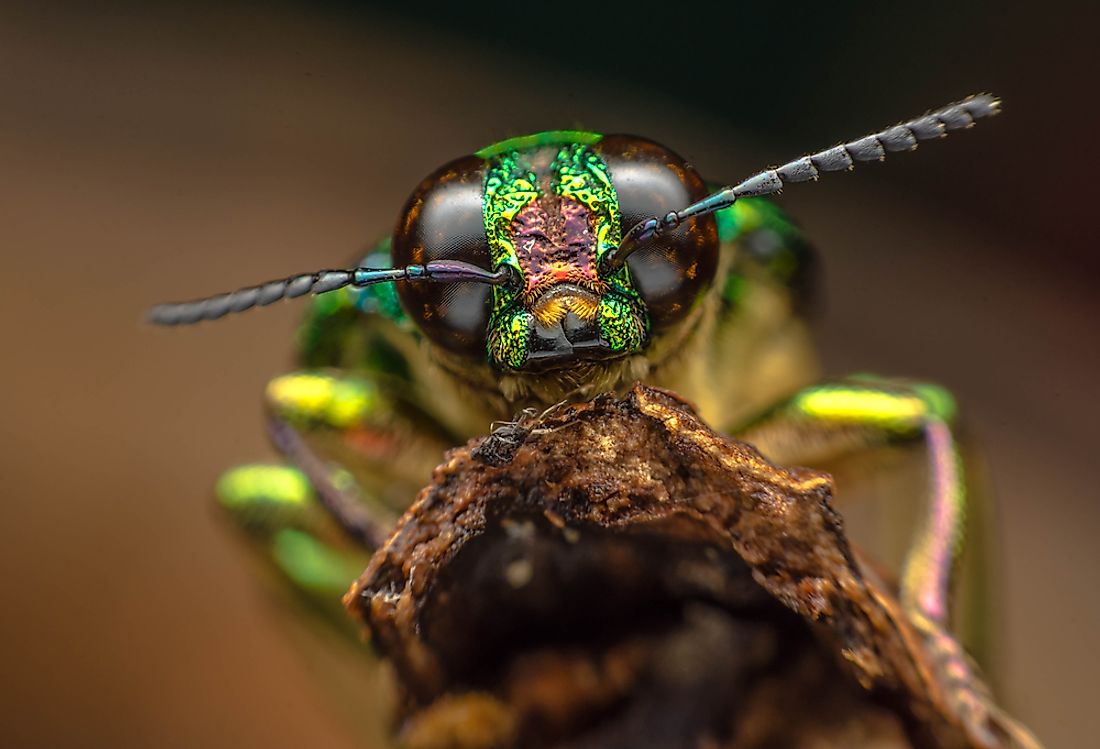Which Species Make Up the Animal Kingdom?

Most animals belong to the biological kingdom Animalia, also known as Metazoa, which are multicellular eukaryotes with differentiating specialized tissues. In addition, most of the members of this kingdom are heterotrophic, motile, and reproduce sexually. Animals depend on each other and on other organisms directly or indirectly for food. A common trend in most animals includes the ability to ingest food and digest it internally. There are 9 to 10 million animal species grouped into vertebrates and invertebrates. There are also 36 phyla within the kingdom like amphibians, reptiles, mammals, and birds. There are over 66,000 vertebrate species and 1.3 million invertebrate species. Insects species are the majority in the entire kingdom accounting for more than half of all living things.
Examples of Animal Species
Vertebrates include fishes, amphibians, mammals, birds, and reptiles while invertebrates include roundworms, ringed worms, flatworms, arthropods, and molluscs, among others.
Insects (Insecta)
There are over one million insect species, however, most are yet to be given names and more have not yet been discovered. Insects belong to the group of hexapod invertebrates within the arthropod phylum. The word insect has a Latin origin, insectum meaning “cut into sections.” Physically, insects have an inelastic chitinous exoskeleton that constrains their growth and their bodies divided into three parts; head, thorax, and abdomen. Most have compound eyes, a pair of antennae, and three pairs of legs. Different species live in almost any environment including some species that reside in the oceans. While developing, insects go through a three or four metamorphosis stages depending on the species. Different adult species may fly, walk or even swim.
Arachnids (Arachnida)
The word arachnid comes from the Greek word aráchnē meaning “spider.” They are joint-legged invertebrate arthropods belonging to the subphylum Chelicerata and there are an estimated 102,248 species. Arachnids basically have two body parts and eight limbs though, in some species, the two front limbs function as sensory organs. The eight legs easily distinguish them from insects that have six legs and, unlike insects, arachnids do not have antennae or wings. Ticks, spiders, scorpions, and mites are all examples of arachnids. Most existing arachnids live on land and few in water.
Fishes
Fish are aquatic craniate animals that have gills and lack limbs. Fish belong to the paraphyly group but are different from tetrapods. Of the 32,900 known fish species, most are cold-blooded (ectothermic) meaning that their body temperatures vary as they move through environments of different temperatures. Fish are present in almost all water environment including freshwater streams, rivers, ponds, lakes, and salty water environments like seas and oceans. Of all the animal species, fish species are the most diverse of the vertebrates in terms of physical features.
Characteristics of Animals
Animals have flexible cells unlike plants, fungi, and algae and, in most species, the embryo goes through a blastula stage which enables their cells to differentiate and form distinct specialized body organs. Animals’ extracellular matrix that contains glycoproteins and collagen cover the eukaryotic cells. This matrix forms the shells, bones, and spicules. In most animals, the body differentiates into different distinct tissues. Nearly all animals have some form of sexual reproduction with a few species capable of producing asexually.
Which Species Make Up the Animal Kingdom?
| Rank | Group | Subgroup | Estimated Number of Species |
|---|---|---|---|
| 1 | Invertebrates | Insects | 1,000,000 |
| 2 | Invertebrates | Arachnids | 102,248 |
| 3 | Invertebrates | Molluscs | 85,000 |
| 4 | Invertebrates | Crustaceans | 47,000 |
| 5 | Verebrates | Fishes | 32,900 |
| 6 | Vertebrates | Birds | 10,425 |
| 7 | Vertebrates | Reptiles | 10,038 |
| 8 | Vertebrates | Amphibians | 7,302 |
| 9 | Vertebrates | Mammals | 5,513 |
| 10 | Invertebrates | Corals | 2,000 |
| 11 | Invertebrates | Velvet worms | 165 |
| 12 | Invertebrates | Horseshoe crabs | 4 |











